Under Marco Rose, Borussia Mönchengladbach are flourishing and contend for a Champions League spot in the Bundesliga 2019/20 campaign. One of Gladbach’s shooting stars is central midfielder, Florian Neuhaus. Due to his role, Neuhaus is not the main focus of attention but still plays a vital part within Gladbach‘s system.
In the following tactical analysis, we are going to explain Florian Neuhaus’ role at Gladbach under Rose. Therefore, we take a closer look at his tasks during the different phases of the game and at his abilities.
Neuhaus’ role within Rose’s Gladbach system
Florian Neuhaus mostly plays as a central midfielder in a double pivot or even in the playmaker role of Gladbach’s 4-2-3-1 or 3-4-1-2 system. Playing these positions, Neuhaus will often move within the half-spaces or centrally behind Gladbach’s attackers occupying space between the opposition lines. On his heatmap, one can recognise the three possible spaces in which Neuhaus is usually positioned. Within either of the two half-spaces or in the “playmaker” area within the central lane and in front of the opposition back line.
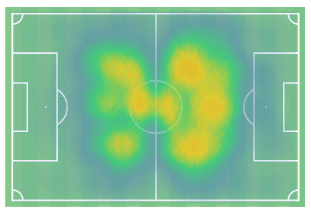
With 39.16 passes per 90 minutes, Neuhaus is not a ball-circulating midfielder like Thiago, however. Neuhaus often stays within the opposition block in order to be in a good position to penetrate the opposition block. By using his ability to both recognise free space and find solutions with the ball in small space, Neuhaus lends Gladbach an attacking threat like not many players could. How Neuhaus does that during the possession and transition phase will be further explained in the following sections of our scout report.
Linking build-up play and attacking phase
During Gladbach’s possession phase, Neuhaus is tasked to connect the build-up play of the centre-backs and the pivot with the attacking phase within the final third. Therefore, Neuhaus likes to drop in front of the opposition midfield to receive the ball.
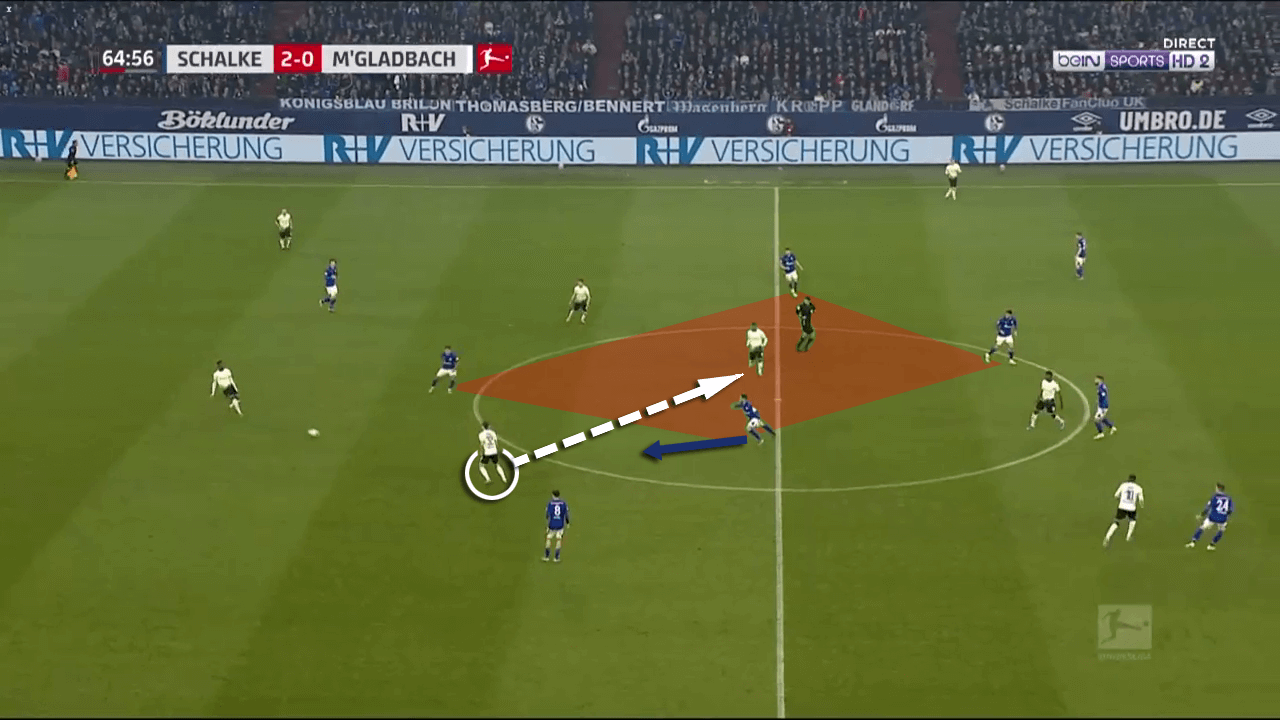
Then, Neuhaus often quickly switches sides and Gladbach attempt to break lines in another lane. Alternatively, Neuhaus utilises the space which opened up in midfield when an opposition midfielder followed him. In this case, an attacking player moves into the space Neuhaus left and receives the ball within the opposition block.
Neuhaus’ role during the possession phase also consists of playing the ball into the main areas where Gladbach aim to penetrate the last line of defence. When receiving the ball within the midfield, the advanced midfielder often prepares the final phase of the attack with an opening pass. Besides his passing abilities, Neuhaus often utilises his dribbling in these scenarios. However, this is not in order to overcome direct opponents but rather to open up passing lanes into dangerous areas.
Therefore, Neuhaus knows what to focus on in order to open up space with the most attacking potential. As Gladbach like to get behind the last line of defence through the wings, for instance, he always takes a look at the widest players of his team compared to the opposition players. In the situation below, Neuhaus recognises that Gladbach’s high right-back could get behind the opposition block if Gladbach can force the opposition players further inside.
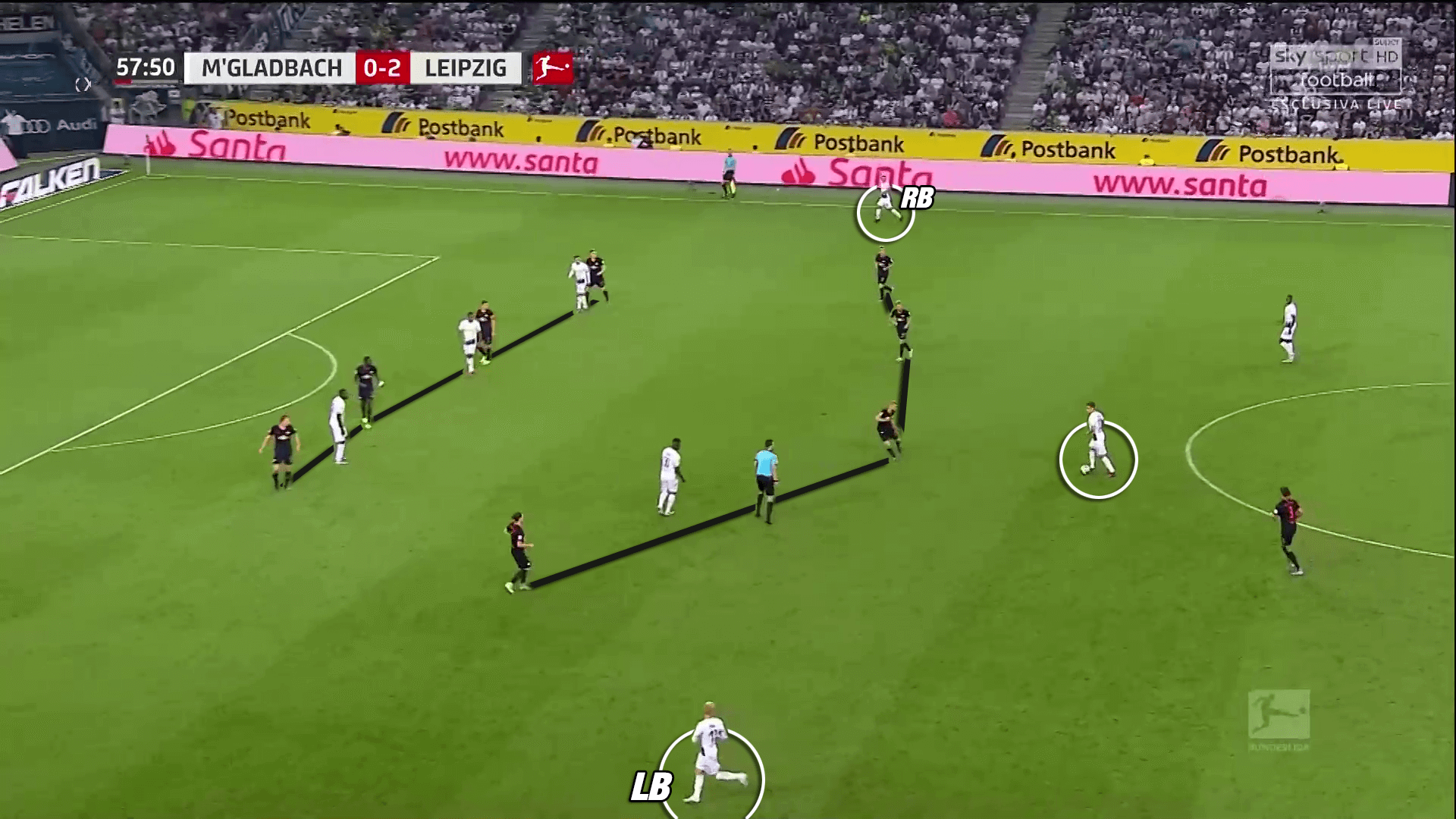
Therefore, Neuhaus dribbles into the centre and therewith forces Leipzig’s formation to narrow. This creates space on the wing and, in addition to that, his dribbling opened up the passing lane towards the right-back.
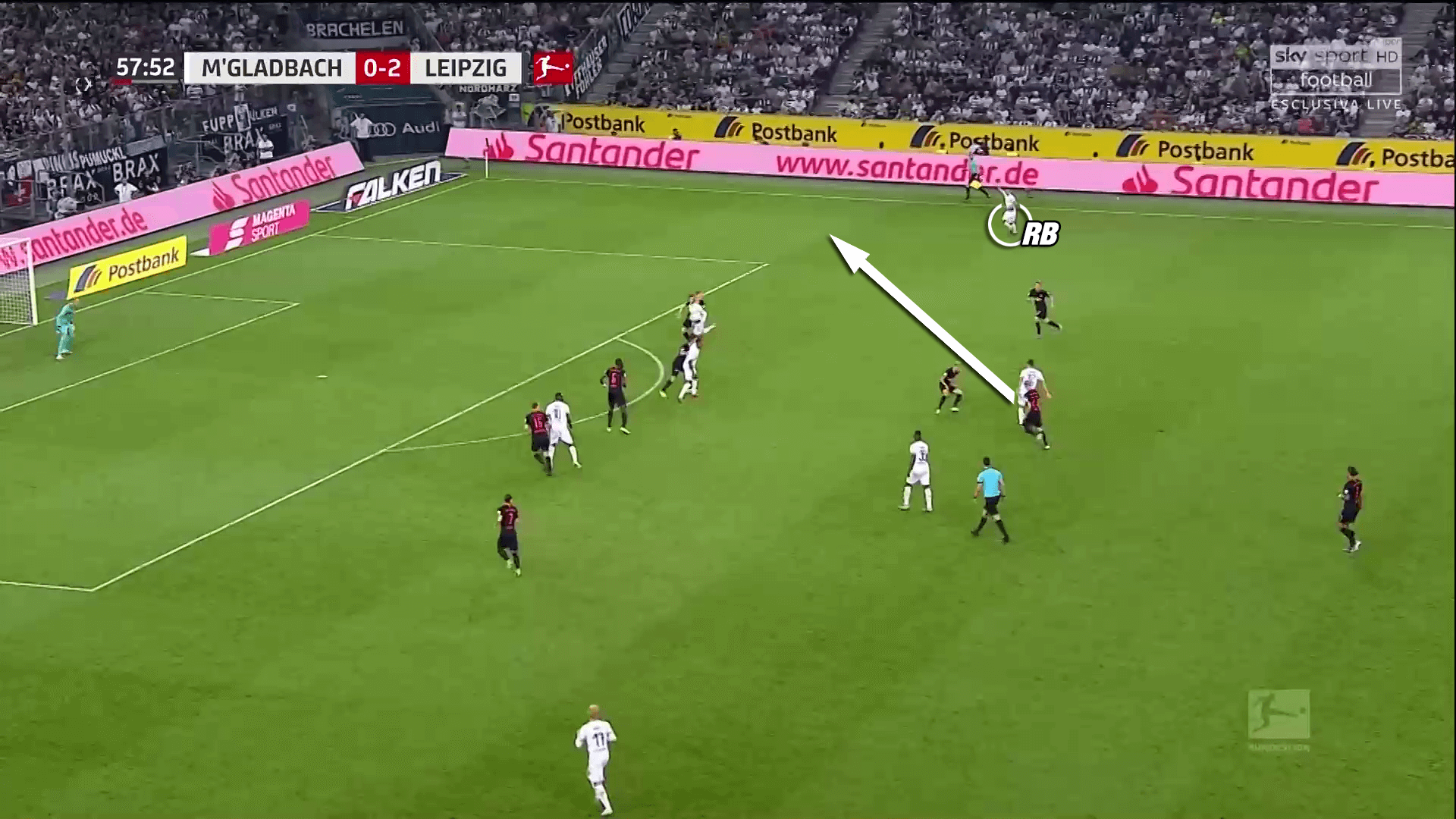
During the final phase of the attack, Neuhaus often stays behind the ball facing the opposition goal and keeping an overview of the opposition defence and the positioning of his teammates. With a diagonal positioning towards his teammates, Neuhaus offers a simple back pass option.
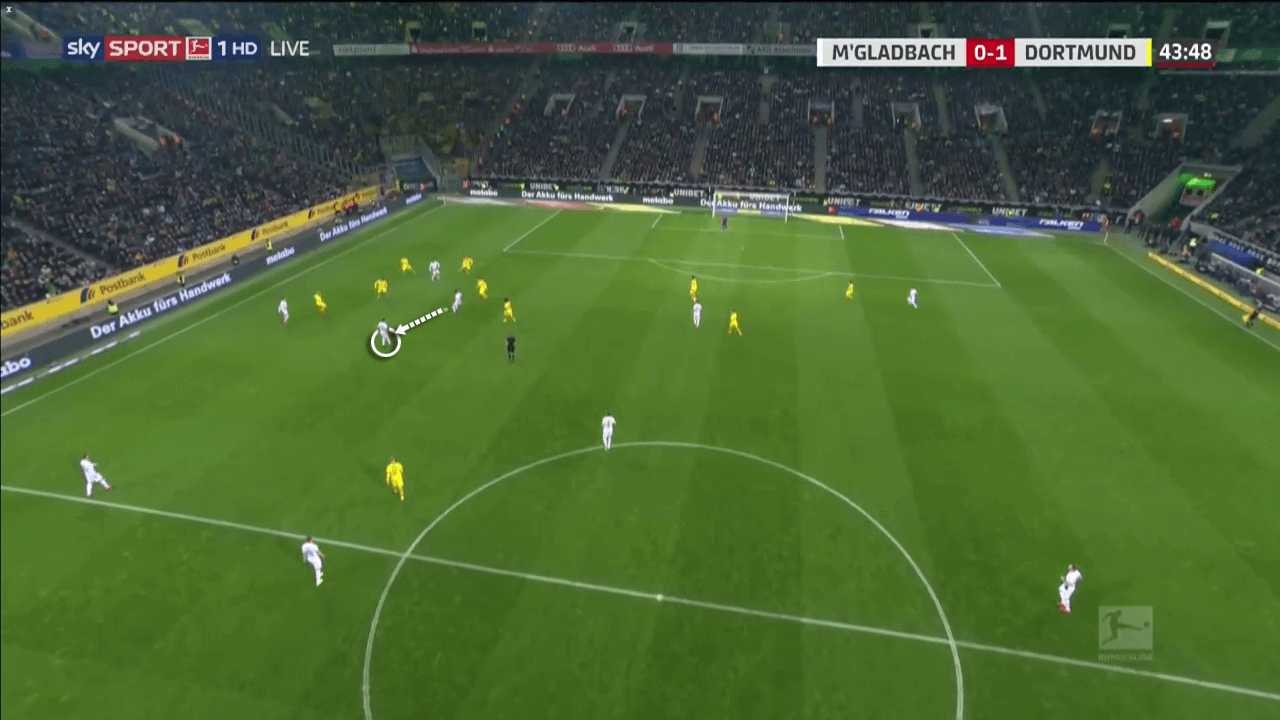
Once receiving the ball in these cases, it is Neuhaus’ task to either decide to change the angle of attack with a switch of play or to penetrate the opposition block with through passes or chipped balls. Since most of the opposition players mainly focus on Gladbach’s attackers near the penalty area, this sometimes allows Neuhaus to move into central a position in front of the opposition back line.
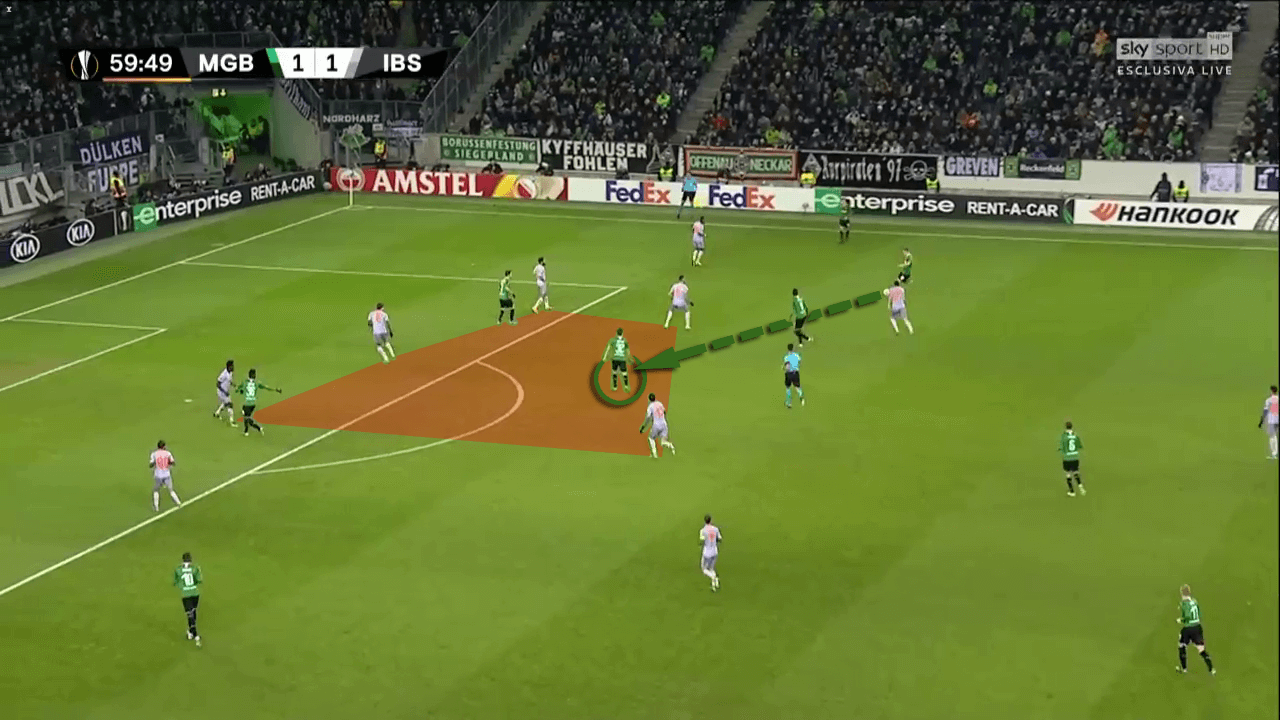
When receiving the ball in such a position, Neuhaus has got various options. Besides his usual actions to play through passes or chipped balls, he then also has got the opportunity to finish the attack on his own. With 1.88 shots on target per 90 minutes, Neuhaus creates an xG-value of 0.21 on average.
Neuhaus during counter-attacks
One of Gladbach’s main strengths under Rose is the offensive transition phase. After a well-executed pressing, Gladbach quickly play towards the opposition goal and create goal-scoring opportunities. In this phase of the game, Florian Neuhaus is one of the main men to feed the attackers with through passes.
Moreover, Neuhaus can recover the ball 5.77 times per 90 minutes within the opposition half. This is a product of Rose’s proactive defending approach seeking for exactly these recoveries by pressing the opposition high up the pitch. Revering the ball himself gives Neuhaus the opportunity to play the first pass after regaining possession. And with Neuhaus’ vision and pre-orientation, this often enables Gladbach to get towards the opposition goal very quickly. While Neuhaus himself lacks pace in order to execute deep runs into pockets, he possesses the ability to recognise gaps within the opposition formation and can exploit them by playing precise through passes or chipped balls into space behind the last line of defence.
When taking a look at Neuhaus’ passes after Gladbach won back the ball, it also becomes clear that Neuhaus attempts to play through passes very often. That also lowers the success rate of his passes into depth. A successful through pass can lead to a good chance while a misplaced pass is not linked with much danger. Therefore, it seems to be part of Neuhaus’ job to risk a ball loss in order to attempt the creation of a possible high-value scoring opportunity. Moreover, with the opposition defender turned backwards to Gladbach’s goal, such balls still allow for counter-pressing.
Conclusion
All in all, Florian Neuhaus is one of Gladbach’s main men in their current season under head-coach Rose. It is not a coincidence that Neuhaus benefits from Rose’s tactics. As shown in our analysis, the tactical approach of Rose suits Neuhaus’ skill set. Gladbach attempt to dominate any opposition with a proactive defending approach and powerful attacks. Neuhaus’ vision and playing intelligence comes to light within this game model since the midfielder is tasked to recognise and exploit free spaces and weak spots of the opposition. With his passing and dribbling abilities, the German advanced midfielder plays a key role at Gladbach and might, in the future, be a candidate for doing the same for the national team.





Comments